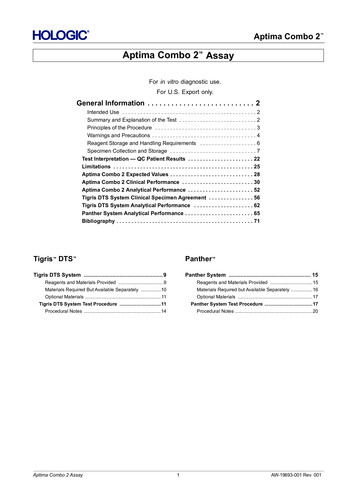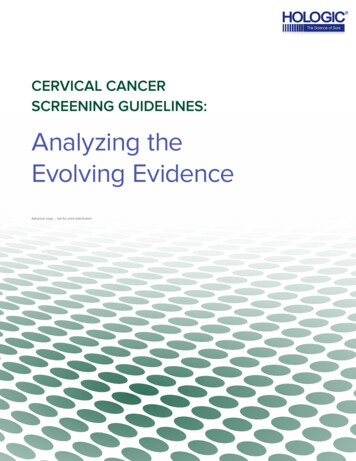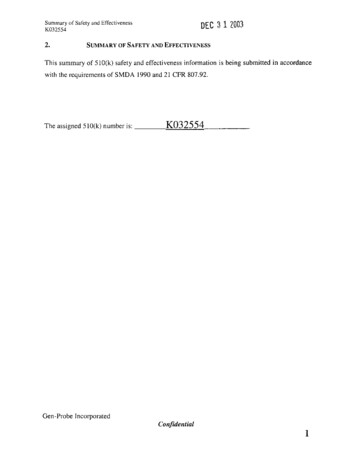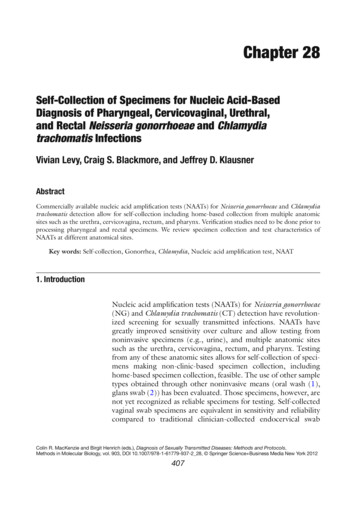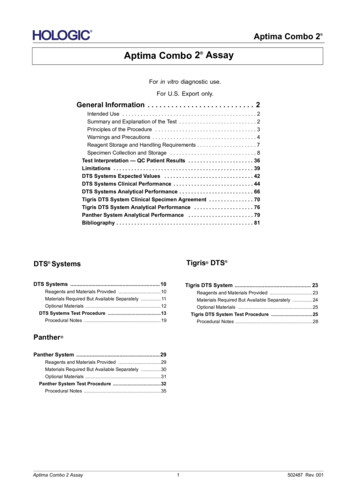
Transcription
Aptima Combo 2 Aptima Combo 2 AssayFor in vitro diagnostic use.For U.S. Export only.General Information . . . . . . . . . . . . . . . . . . . . . . . . . . . 2Intended Use . . . . . . . . . . . . . . . . . . . . . . . . . . . . . . . . . . . . . . . . . . . . . 2Summary and Explanation of the Test . . . . . . . . . . . . . . . . . . . . . . . . . . 2Principles of the Procedure . . . . . . . . . . . . . . . . . . . . . . . . . . . . . . . . . . 3Warnings and Precautions . . . . . . . . . . . . . . . . . . . . . . . . . . . . . . . . . . . 4Reagent Storage and Handling Requirements . . . . . . . . . . . . . . . . . . . . 7Specimen Collection and Storage . . . . . . . . . . . . . . . . . . . . . . . . . . . . . 8Test Interpretation — QC Patient Results . . . . . . . . . . . . . . . . . . . . . . 36Limitations . . . . . . . . . . . . . . . . . . . . . . . . . . . . . . . . . . . . . . . . . . . . . . . 39DTS Systems Expected Values . . . . . . . . . . . . . . . . . . . . . . . . . . . . . . 42DTS Systems Clinical Performance . . . . . . . . . . . . . . . . . . . . . . . . . . . 44DTS Systems Analytical Performance . . . . . . . . . . . . . . . . . . . . . . . . . 66Tigris DTS System Clinical Specimen Agreement . . . . . . . . . . . . . . . 70Tigris DTS System Analytical Performance . . . . . . . . . . . . . . . . . . . . 76Panther System Analytical Performance . . . . . . . . . . . . . . . . . . . . . . 79Bibliography . . . . . . . . . . . . . . . . . . . . . . . . . . . . . . . . . . . . . . . . . . . . . . 81DTS SystemsTigris DTS DTS Systems .10Tigris DTS System . 23Reagents and Materials Provided .10Reagents and Materials Provided .23Materials Required But Available Separately . 11Materials Required But Available Separately .24Optional Materials .12Optional Materials .25DTS Systems Test Procedure .13Tigris DTS System Test Procedure .25Procedural Notes .19Procedural Notes .28Panther Panther System .29Reagents and Materials Provided .29Materials Required But Available Separately .30Optional Materials .31Panther System Test Procedure .32Procedural Notes .35Aptima Combo 2 Assay1502487 Rev. 001
Aptima Combo 2General Information General InformationIntended UseThe Aptima Combo 2 Assay is a target amplification nucleic acid probe test that utilizestarget capture for the in vitro qualitative detection and differentiation of ribosomal RNA(rRNA) from Chlamydia trachomatis (CT) and/or Neisseria gonorrhoeae (GC) to aid in thediagnosis of chlamydial and/or gonococcal urogenital disease using the Tigris DTS Systemor Panther System or using the DTS Systems semi-automated instrumentation as specified.The assay may be used to test the following specimens from symptomatic individuals:clinician-collected endocervical, vaginal and male urethral swab specimens; and female andmale urine specimens. The assay may be used to test the following specimens fromasymptomatic individuals: clinician-collected endocervical, vaginal and male urethral swabspecimens; patient-collected vaginal swab specimens1; and female and male urinespecimens. This assay is also intended for use with the testing of gynecological specimens,from both symptomatic and asymptomatic patients. These cervical specimens collected in thePreservCyt Solution vials may be tested either pre- or post-Pap processing. Testing of postPap processed specimens is limited to specimens processed with the ThinPrep 2000System only.1Patient-collected vaginal swab specimens are an option for screening women when a pelvic exam is nototherwise indicated. The vaginal swab specimen collection kit is not for home use.Summary and Explanation of the TestChlamydia trachomatis (CT) and Neisseria gonorrhoeae (GC) infections are two of the mostcommon sexually transmitted infections worldwide. In the United States alone, an estimated1,307,893 (426.0 cases per 100,000 population) new cases of CT and 309,341 (100.8 per100,000 population) new cases of GC infections were reported to the Centers for DiseaseControl in 2010 (5).Chlamydiae are nonmotile, gram-negative, obligate intracellular bacteria. The CT species iscomprised of fifteen serovars (A, B, Ba, C, D, E, F, G, H, I, J, K, L1, L2 and L3) that cancause disease in humans (34). The serovars D through K are the major cause of genitalchlamydial infections in men and women (26). C. trachomatis can cause nongonococcalurethritis, epididymitis, proctitis, cervicitis, acute salpingitis, and Pelvic Inflammatory Disease(PID) (3, 15, 28, 29). C. trachomatis infections are often asymptomatic in both males andfemales. Children born to infected mothers are at significantly higher risk for inclusionconjunctivitis and chlamydial pneumonia (1, 11, 27).Historically, several methods for CT detection have been utilized in the clinical laboratory,including cell culture, direct fluorescent antibody testing, and enzyme immunoassay. Morerecent methodologies for CT detection include direct DNA probe assays and nucleic acidamplification test (NAAT) DNA probe assays. Cell culture was once considered to be the“gold standard” for detection of CT. Culture is quite specific, but scientific publications havedemonstrated that the NAAT DNA probe technologies have a higher clinical sensitivity thanculture (2, 9, 17, 30). Due to its lower clinical sensitivity and variable performance betweenlaboratories, culture has been replaced in many laboratories by direct DNA probe andNAATs.N. gonorrhoeae is the causative agent of gonorrheal disease. N. gonorrhoeae are non-motile,gram-negative diplococci. The majority of gonorrheal infections are uncomplicated lowergenital tract infections and may be asymptomatic. However, if left untreated in women,infections can ascend and cause PID. PID can manifest as endometritis, salpingitis, pelvicAptima Combo 2 Assay2502487 Rev. 001
Aptima Combo 2 General Informationperitonitis, and tubo-ovarian abscesses. A smaller percentage of persons with gonococcalinfections may develop Disseminated Gonococcal Infection (DGI) (14, 20).Conventional diagnosis of GC infection requires isolation of the organism on selective mediaor the observation of diplococci in Gram stained smears (16). Culture methods can havegood clinical sensitivity, but are highly dependent on proper specimen handling. Improperspecimen storage and transport can result in the loss of organism viability and yield falsenegative results. In addition, poor sampling technique, toxic sampling materials, and theinhibition of growth by components of body secretions can also result in false negativeresults (7, 18). Commonly used non-culture methods for GC detection include direct DNAprobe tests and NAATs.First generation NAATs for CT and GC have technological issues that have limited theirperformance. These issues include cumbersome specimen processing and specimeninhibition that can yield false negative results (6, 10, 13, 19, 25, 31, 32, 33). The AptimaCombo 2 Assay is a second generation NAAT that utilizes target capture, TranscriptionMediated Amplification (TMA ), and Dual Kinetic Assay (DKA) technologies to streamlinespecimen processing, amplify target rRNA, and detect amplicon, respectively. Studiescomparing performance and specimen inhibition of various amplification systems havedemonstrated the benefits of target capture, TMA, and DKA technologies (8, 12). The AptimaCombo 2 Assay qualitatively detects CT and/or GC rRNA in clinician-collected endocervical,vaginal, and male urethral swab specimens, patient-collected vaginal swab specimens,PreservCyt Solution liquid Pap specimens, and in female and male urine specimens fromsymptomatic and asymptomatic individuals.Principles of the ProcedureThe Aptima Combo 2 Assay combines the technologies of target capture, TMA, and DKA.Specimens are collected and transferred into their respective specimen transport tubes. Thetransport solutions in these tubes release the rRNA targets and protect them fromdegradation during storage. When the Aptima Combo 2 Assay is performed in the laboratory,the target rRNA molecules are isolated from specimens by use of capture oligomers viatarget capture that utilizes magnetic microparticles. The capture oligomers contain sequencescomplementary to specific regions of the target molecules as well as a string ofdeoxyadenosine residues. A separate capture oligomer is used for each target. During thehybridization step, the sequence specific regions of the capture oligomers bind to specificregions of the target molecules. The capture oligomer:target complex is then captured out ofsolution by decreasing the temperature of the reaction to room temperature. Thistemperature reduction allows hybridization to occur between the deoxyadenosine region onthe capture oligomer and the poly-deoxythymidine molecules that are covalently attached tothe magnetic particles. The microparticles, including the captured target molecules bound tothem, are pulled to the side of the reaction vessel using magnets and the supernatant isaspirated. The particles are washed to remove residual specimen matrix that may containamplification reaction inhibitors. After the target capture steps are completed, the specimensare ready for amplification.Target amplification assays are based on the ability of complementary oligonucleotideprimers to specifically anneal and allow enzymatic amplification of the target nucleic acidstrands. The Aptima Combo 2 Assay replicates a specific region of the 23S rRNA from CTand a specific region of the 16S rRNA from GC via DNA intermediates. A unique set ofprimers is used for each target molecule. Detection of the rRNA amplification productsequences (amplicon) is achieved using nucleic acid hybridization. Single-strandedchemiluminescent DNA probes, which are complementary to a region of each targetAptima Combo 2 Assay3502487 Rev. 001
Aptima Combo 2General Information amplicon, are labeled with different acridinium ester molecules. The labeled DNA probescombine with amplicon to form stable RNA:DNA hybrids. The Selection Reagentdifferentiates hybridized from unhybridized probe, eliminating the generation of signal fromunhybridized probe. During the detection step, light emitted from the labeled RNA:DNAhybrids is measured as photon signals in a luminometer, and are reported as Relative LightUnits (RLU). In DKA, differences in the kinetic profiles of the CT and GC labeled probesallow for the differentiation of signal; kinetic profiles are derived from measurements ofphoton output during the detection read time. The chemiluminescent detection reaction forCT signal has very rapid kinetics and has the “flasher” kinetic type. The chemiluminescentdetection reaction for GC signal is relatively slower and has the “glower” kinetic type. Assayresults are determined by a cut-off based on the total RLU and the kinetic curve type.Warnings and PrecautionsA. For in vitro diagnostic use.B. For additional specific warnings, precautions and procedures to control contamination forthe Tigris DTS System, consult the Tigris DTS System Operator’s Manual.C. For additional specific warnings, precautions and procedures to control contamination forthe Panther System, consult the Panther System Operator’s Manual.Laboratory RelatedD. The assay was not evaluated in patient populations with a low prevalence of CT disease;therefore, performance in low prevalence settings has not been determined.E. Use only supplied or specified disposable laboratory ware.F. Use routine laboratory precautions. Do not eat, drink or smoke in designated work areas.Wear disposable, powderless gloves, protective eye wear, and laboratory coats whenhandling specimens and kit reagents. Wash hands thoroughly after handling specimensand kit reagents.G. Warning: Irritants and Corrosives: Avoid contact of Auto Detect 1 and Auto Detect 2with skin, eyes and mucous membranes. If these fluids come into contact with skin oreyes, wash with water. If spills of these fluids occur, dilute with water before wiping dry.H. Work surfaces, pipettes, and other equipment must be regularly decontaminated with2.5% to 3.5% (0.35 M to 0.5 M) sodium hypochlorite solution.DTS Systems SpecificI.A separate area for DKA is strongly recommended to minimize amplicon contamination inthe assay. This dedicated area should be away from the reagent preparation, targetcapture, and amplification area.J. To help prevent lab areas from becoming contaminated with amplicon, the laboratoryarea should be arranged with a unidirectional workflow: from reagent preparation throughDKA. Specimens, equipment, and reagents should not be returned to the area where aprevious step was performed. Also, personnel should not move back into previous workareas without proper contamination safeguards.Aptima Combo 2 Assay4502487 Rev. 001
Aptima Combo 2 General InformationSpecimen RelatedK. This assay has been tested using endocervical and male urethral swab specimens,PreservCyt Solution liquid Pap specimens, vaginal swab specimens, female and maleurine specimens only. Performance with specimens other than those specified underSpecimen Collection and Storage has not been evaluated.Laboratories may validate other collection devices (21, 23).Gynecologic samples collected for preparation using the ThinPrep 2000 System shouldbe collected using broom-type or endocervical brush/plastic spatula combinationcollection devices.L. Expiration dates listed on the collection kits pertain to the collection site and not thetesting facility. Samples collected any time prior to the expiration date of the collection kit,and transported and stored in accordance with the package insert, are valid for testingeven if the expiration date on the collection tube has passed.M. The PreservCyt Solution has been validated as an alternative medium for testing withAptima Combo 2 Assay. PreservCyt Solution liquid Pap specimens processed using theThinPrep 3000 Processor or other instruments have not been evaluated to test forChlamydia trachomatis and Neisseria gonorrhoeae using Aptima Combo 2 Assay.N. After urine has been added in the urine transport tube, the liquid level must fall betweenthe two black indicator lines on the tube label. Otherwise, the specimen must be rejected.O. Maintain proper storage conditions during specimen shipping to ensure the integrity of thespecimen. Specimen stability under shipping conditions other than those recommendedhas not been evaluated.P. Specimens may be infectious. Use Universal Precautions when performing this assay.Proper handling and disposal methods should be established by the laboratory director.Only personnel adequately trained in handling infectious materials should be permitted toperform this diagnostic procedure.Q. Avoid cross-contamination during the specimen handling steps. Specimens can containextremely high levels of organisms. Ensure that specimen containers do not contact oneanother, and discard used materials without passing over open containers. Changegloves if they come in contact with specimen.R. If the lab receives a swab specimen transport tube with no swab, two swabs, a cleaningswab, or a swab not supplied by Hologic, the specimen must be rejected. Prior torejecting a swab transport tube with no swab, verify that it is not an Aptima SpecimenTransfer Tube as this specimen transport tube will not contain a swab.S. For PreservCyt Solution liquid Pap specimens, collect according to the manufacturer’sinstructions. Aliquots subsequently removed from the PreservCyt vial for testing by theAptima Combo 2 Assay should be processed using only the Aptima Specimen TransferKit.T. Upon piercing, liquid can discharge from Aptima transport tube caps under certainconditions. Follow instructions in the appropriate Test Procedure to prevent thisoccurrence.Aptima Combo 2 Assay5502487 Rev. 001
Aptima Combo 2General Information Assay RelatedU. The performance of vaginal swab specimens has not been evaluated in pregnant women.V. The performance of endocervical, vaginal, and male urethral swab specimens, male andfemale urine specimens, and PreservCyt Solution liquid Pap specimens has not beenevaluated in adolescents less than 16 years of age.W. Do not use this kit after its expiration date.X. Do not interchange, mix, or combine assay reagents from kits with different lotnumbers. Aptima controls and assay fluids can be from different lot numbers.DTS Systems SpecificY. Tips with hydrophobic plugs must be used. A minimum of two repeat pipettors must bededicated for use with this assay: one for use in the target capture and amplificationsteps, and one for use in the DKA steps. Two micropipettors must be dedicated for use inthis assay: one for use in specimen transfer and one for use in reagent preparation. Allpipettors must be cleaned regularly as described in DTS Systems Test Procedure,Procedural Notes.Z. When using repeat pipettors for reagent addition, do not touch the tube with the pipettetip to prevent carryover from one tube to another.AA.Adequate mixing is necessary to achieve accurate assay results. For complete details,see DTS Systems Test Procedure, Procedural Notes.AB.Separate water baths must be dedicated for the target capture, amplification, and DKAsteps in the assay.AC.Sealing cards should be disposed of in the waste container immediately after removingthem from reaction tubes. Fresh sealing cards should always be used: they should neverbe re-used from a previous step. Sealing cards should be firmly fixed to the top of allreaction tubes.Aptima Combo 2 Assay6502487 Rev. 001
Aptima Combo 2 General InformationReagent Storage and Handling RequirementsA. The following reagents are stable when stored at 2 C to 8 C (refrigerated):Aptima Combo 2 Amplification ReagentAptima Combo 2 Enzyme ReagentAptima Combo 2 Probe ReagentAptima Combo 2 Target Capture Reagent BAptima Positive Control, CT / Negative Control, GCAptima Positive Control, GC / Negative Control, CTB. The following reagents are stable when stored at 2 C to 30 C:Aptima Combo 2 Amplification Reconstitution SolutionAptima Combo 2 Enzyme Reconstitution SolutionAptima Combo 2 Probe Reconstitution SolutionAptima Combo 2 Selection ReagentC. The following reagents are stable when stored at 15 C to 30 C (room temperature):Target Capture ReagentAptima Wash SolutionAptima Buffer for Deactivation FluidAptima Oil ReagentD. Working Target Capture Reagent (wTCR) is stable for 30 days when stored at 15 C to30 C. Do not refrigerate.E. After reconstitution, the Enzyme Reagent, Amplification Reagent, and Probe Reagent arestable for 30 days when stored at 2 C to 8 C.F. Discard any unused reconstituted reagents and wTCR after 30 days or after the MasterLot expiration date passes, whichever comes first.G. Controls are stable until the date indicated on the vials.H. Reagents stored on-board the Tigris DTS System have 48 hours of on-board stability.I.Reagents stored on-board the Panther System have 72 hours of on-board stability.J. The Probe Reagent and Reconstituted Probe Reagent are photosensitive. Store thereagents protected from light. The specified reconstituted stability is based on 12 hoursexposure of the Reconstituted Probe Reagent to two 60W fluorescent bulbs, at adistance of 17 inches (43 cm), and temperature less than 30 C. Light exposure of theReconstituted Probe Reagent should be limited accordingly.K. Upon warming to room temperature, some control tubes may appear cloudy or containprecipitates. Cloudiness or precipitation associated with controls does not affect controlperformance. The controls may be used whether they are clear or cloudy/precipitated. Ifclear controls are desired, solubilization may be expedited by incubating them at theupper end of the room temperature range (15 C to 30 C).L. Do not freeze the reagents.Aptima Combo 2 Assay7502487 Rev. 001
Aptima Combo 2General Information Specimen Collection and StorageThe Aptima Combo 2 Assay is designed to detect the presence of CT and GC in thefollowing specimens: endocervical and male urethral swab specimens, vaginal swabspecimens, PreservCyt Solution liquid Pap specimens, and in female and male urinespecimens. Performance with specimens other than those collected with the followingspecimen collection kits has not been evaluated: Aptima Unisex Swab Specimen Collection Kit for Endocervical and Male Urethral SwabSpecimens Aptima Urine Collection Kit for Male and Female Urine Specimens Aptima Vaginal Swab Specimen Collection Kit Aptima Specimen Transfer Kit (for use with gynecologic samples collected in PreservCytSolution)A. Instructions for collection:Refer to the appropriate specimen collection kit package insert for collection instructions.B. Specimen transport and storage before testing:1. Swab specimens:a. After collection, transport and store the swab in the swab specimen transport tube at2 C to 30 C until tested. Specimens must be assayed with the Aptima Combo 2Assay within 60 days of collection. If longer storage is needed, freeze at -20 C to -70 C for up to 12 months after collection (see Specimen Stability Studies).2. Urine specimens:a. Urine samples that are still in the primary collection container must be transported tothe lab at 2 C to 30 C. Transfer the urine sample into the Aptima urine specimentransport tube within 24 hours of collection. Store at 2 C to 30 C and test within 30days of collection.b. After collection, transport the processed urine specimens in the Aptima urinespecimen transport tube at 2 C to 30 C and store at 2 C to 30 C until tested.Processed urine specimens should be assayed with the Aptima Combo 2 Assaywithin 30 days of collection. If longer storage is needed, freeze at -20 C to -70 C forup to 12 months after collection (see Specimen Stability Studies).3. PreservCyt Solution liquid Pap specimens:a. PreservCyt Solution liquid Pap specimens intended for CT and/or GC testing must beprocessed for cytology and/or transferred to an Aptima Specimen Transfer tubewithin 30 days of collection when stored at 2 C to 30 C (see Specimen StabilityStudies).b. If the ThinPrep Aliquot Removal procedure will be used, refer to the ThinPrep 2000or ThinPrep 3000 Processor Operator’s Manual—Addendum for instructions onaliquot removal. Transfer 1 mL of the removed aliquot into an Aptima SpecimenTransfer tube according to the instructions in the Aptima Specimen Transfer Kitpackage insert.c. If testing the specimen after processing using the ThinPrep 2000 processor, processthe PreservCyt Solution liquid Pap specimen in accordance with the ThinPrep 2000Processor Operator's Manual and the Aptima Specimen Transfer Kit package insert.Transfer 1 mL of the fluid remaining in PreservCyt Solution vial into an AptimaAptima Combo 2 Assay8502487 Rev. 001
Aptima Combo 2 General InformationSpecimen Transfer tube according to the instructions in the Aptima SpecimenTransfer Kit package insert.d. Once the PreservCyt Solution liquid Pap specimen is transferred to the AptimaSpecimen Transfer tube, the specimen must be assayed with the Aptima Combo 2Assay within 30 days when stored at 2 C to 8 C or 14 days when stored at 15 C to30 C. If longer storage is needed, freeze at -20 C to -70 C for up to 12 months aftertransfer (see Specimen Stability Studies).C. Specimen storage after testing:1. Specimens that have been assayed must be stored upright in a rack.2. The specimen transport tubes should be covered with a new, clean plastic film or foilbarrier.3. If assayed samples need to be frozen or shipped, remove penetrable cap and placenew non-penetrable caps on the specimen transport tubes. If specimens need to beshipped for testing at another facility, recommended temperatures must be maintained.Prior to uncapping previously tested and recapped samples, specimen transport tubesmust be centrifuged for 5 minutes at 420 Relative Centrifugal Force (RCF) to bring all ofthe liquid down to the bottom of the tube. Avoid splashing and cross-contamination.Note: Specimens must be shipped in accordance with applicable national andinternational transportation regulations.Aptima Combo 2 Assay9502487 Rev. 001
Aptima Combo 2DTS Systems DTS SystemsReagents for the Aptima Combo 2 Assay for CT and GC are listed below for the DTSSystems. Reagent Identification Symbols are also listed next to the reagent name.Reagents and Materials ProvidedNote: For information on any hazard and precautionary statements that may be associatedwith reagents, refer to the Safety Data Sheet Library at www.hologic.com/sds.Aptima Combo 2 Assay Kit, 100 tests (2 boxes) (Cat. No. 301032)Aptima Combo 2 Refrigerated Box (Box 1 of 2) (store at 2 C to 8 C upon receipt)SymbolComponentQuantityAAptima Combo 2 Amplification ReagentNon-infectious nucleic acids dried in buffered solutioncontaining 5% bulking agent.1 vialEAptima Combo 2 Enzyme ReagentReverse transcriptase and RNA polymerase dried in HEPESbuffered solution containing 10% bulking reagent.1 vialPAptima Combo 2 Probe ReagentNon-infectious chemiluminescent DNA probes dried insuccinate buffered solution containing 5% detergent.1 vialTCR-BAptima Combo 2 Target Capture Reagent BNon-infectious nucleic acids in buffered solution containing 5% detergent.1 x 0.35 mLPCT/NGCAptima Positive Control, CT / Negative Control, GCNon-infectious CT nucleic acid in a buffered solutioncontaining 5% detergent. Each 400 µL sample contains theestimated rRNA equivalent of 1 CT IFU (5 fg/assay*).3 x 1.7 mLPGC/NCTAptima Positive Control, GC / Negative Control, CTNon-infectious GC nucleic acid in a buffered solutioncontaining 5% detergent. Each 400 µL sample contains theestimated rRNA equivalent of 50 GC cells (250 fg/assay*).3 x 1.7 mL*The rRNA equivalents were calculated based on the genome size and estimated DNA:RNA ratio/cell of each organism.Also included in the refrigerated box are the following (Storage Tray):(store at 2 C to 30 C upon receipt)SymbolComponentQuantityARAptima Combo 2 Amplification Reconstitution SolutionAqueous solution containing preservatives.1 x 9.3 mLERAptima Combo 2 Enzyme Reconstitution SolutionHEPES buffered solution containing a surfactant and glycerol.1 x 3.3 mLPRAptima Combo 2 Probe Reconstitution SolutionSuccinate buffered solution containing 5% detergent.1 x 12.4 mLAptima Combo 2 Assay10502487 Rev. 001
Aptima Combo 2 DTS SystemsAlso included in the refrigerated box are the following (Storage Tray):(store at 2 C to 30 C upon receipt)SymbolSComponentQuantityAptima Combo 2 Selection Reagent600 mM borate buffered solution containing surfactant.1 x 31 mL3Reconstitution Collars1 packageSealing CardsAptima Combo 2 Room Temperature Box (Box 2 of 2) (store at 15 C to 30 C upon receipt)SymbolTCRComponentQuantityAptima Combo 2 Target Capture ReagentBuffered salt solution containing solid phase and captureoligomers.1 x 22 mLWAptima Wash Solution10 mM HEPES buffered solution containing 2% detergent.1 x 402 mLDFAptima Buffer for Deactivation Fluid800 mM bicarbonate buffered solution.1 x 402 mLOAptima Oil ReagentSilicone Oil.1 x 24.6 mLMaterials Required But Available SeparatelyNote: Materials available from Hologic have catalog numbers listed, unless otherwise specified.Cat. No.Leader HC Luminometer104747-01Hologic Target Capture System (TCS)104555Incubators and vortexers:2 Multi-tube vortex mixers3 Circulating water baths(62 C 1 C, 42 C 1 C, 62 C 1 C)3 Water bath spacers102160104586 104627OR2 SB100 Dry Heat Bath/Vortexers105524Additional SB100 baths may be required as test volume increasesAptima Auto Detect Kit3010482 eppendorf Repeater Plus pipettors1057252 pipettors, 1000 µL RAININ PR1000901715eppendorf pipettor, 20 µL to 200 µL105726Repeat pipettor tips, 2.5 mL21-381-329Repeat pipettor tips, 5.0 mL21-381-330Repeat pipettor tips, 25.0 mL21-381-115Aptima Combo 2 Assay11502487 Rev. 001
Aptima Combo 2DTS Systems Cat. No.Tips, P1000 Style105049special diameter tip only available from HologicPipette tips 20 µL to 200 µL705512 (Fisher)Ten Tube Units (TTU)TU0022Ten Tip Cassettes (TTC)104578Aptima Unisex Swab Specimen Collection Kit for Endocervical and 301041Male Urethral Swab SpecimensAptima Urine Specimen Collection Kit for Male and Female UrineSpecimens301040Aptima Urine Specimen Transport Tubes for Male and FemaleUrine Specimens105575Aptima Vaginal Swab Specimen Collection Kit301162Aptima Specimen Transfer Kit301154CSysCheck calibration standard301078Bleach, 5% to 7% (0.7 M to 1.0 M) sodium hypochlorite solution—Standard urine collection containers, without preservatives—Large-capped plastic container—Aptima penetrable caps105668Replacement non-penetrable caps103036AOptional MaterialsCat. No.Hologic Bleach Enhancer for Cleaning302101for routine cleaning of surfaces and equipmentAptima Controls Kit301110Aptima Assay Fluids302002C(Aptima Wash Solution, Aptima Buffer for Deactivation Fluid, and Aptima OilReagent)STD Proficiency Panel102325Tips, 1000 µL conductive, liquid sensing10612513 (Tecan)TECAN Freedom EVO 100/4900932DTS 800 Systems Aptima Combo 2 Deck PlateReagent reservoir (40 mL quarter module)Split reagent reservoir (19 mL x 2 quarter module)Aptima Combo 2 Assay12105200104765104763502487 Rev. 001
Aptima Combo 2 DTS SystemsDTS Systems Test ProcedureA. Equipment Preparation1. Adjust one water bath to 62 C 1 C (for target capture, and primer
Aptima Combo 2 Assay 2 502487 Rev. 001 General Information Aptima Combo 2 General Information Intended Use The Aptima Combo 2 Assay is a target amplification nucleic acid probe test that utilizes target capture for the in vitro qualitative detection and differentiation of ribosomal RNA (rRNA) from Chlamydia trachomatis (CT) and/or Neisseria gonorrhoeae (GC) to aid in the
